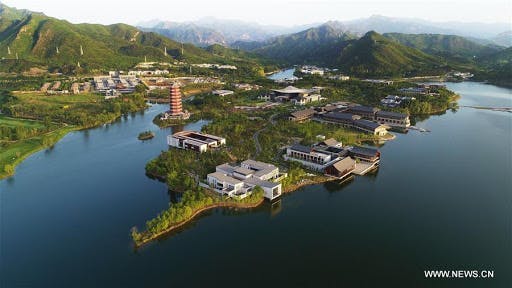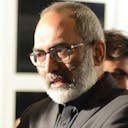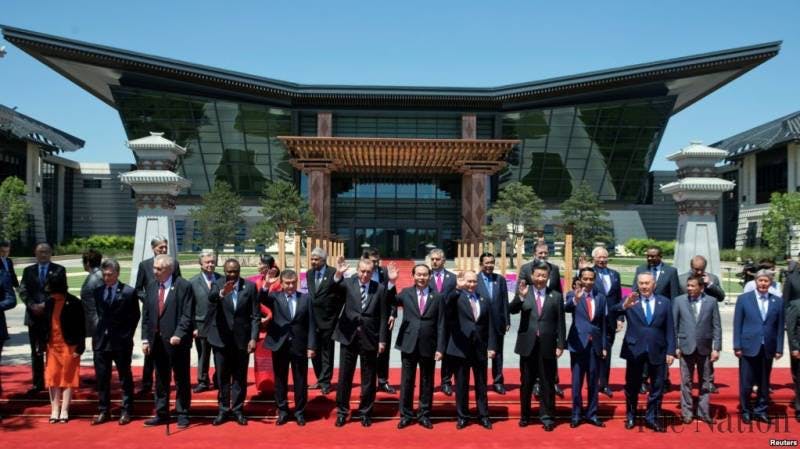What is reshaping the world while we are unaware?

What is happening this weekend that can reshape the world while we are unaware because our media won’t tell us?
What is happening this weekend that can potentially reshape the world – or at least this part of Asia? Some media refer to it as Globalisation 2.0.
If I give you 30 seconds to guess, you may not be able to make it. Partly because our mainstream print and electronic media – even social media – is quiet about this. There may not have been many shows on prime-time national TV, or columns by well-read journalists. Because current-affairs media is busy in educating us on other more urgent issues of national interest (see Project Ignorance).
Some – still little though – attention may be diverted to this event because country’s prime minister is attending it. However, the coverage you will receive may be of PM’s attendance, but not the actual event. The event is what is significant in all of this.
OK, I won’t test your patience. Here it is. The venue is Beijing’s Yanqi Lake resort. The event is Belt and Road Forum for International Cooperation (BRF). The dates are: 14-15 May 2017.
The Belt and Road Initiative (BRI) is also called One Belt, One Road, or OBOR for short.
So, what signifies this BRF?
First, 29 overseas heads of states or governments including PM Nawaz Sharif are attending it. The host is Chinese President Xi Jinping. Xi is no ordinary President and China is no ordinary country.
The Beijing BRF is the biggest show of strength by Xi’s China where everyone who matters in the world will show up. Of course, not from the US, and its European and Asian allies – India, Japan and South Korea. The US is sending a representative to attend.
India considers China as a regional and global rival, and since the BRF’s theme is cooperation, and not competition, it has decided to stay away.
A list of world leaders attending the BRF:
- Argentinean President Mauricio Macri
- Belarusian President Alexander Lukashenko
- Cambodian Prime Minister Hun Sen
- Chilean President Michelle Bachelet
- Czech President Milos Zeman
- Ethiopian Prime Minister Hailemariam Dessalegn
- Fijian Prime Minister Voreqe Bainimarama
- Greek Prime Minister Alexis Tsipras
- Hungarian Prime Minister Viktor Orban
- Indonesian President Joko Widodo
- Italian Prime Minister Paolo Gentiloni
- Kazakh President Nursultan Nazarbayev
- Kenyan President Uhuru Kenyatta
- Kyrgyz President Almazbek Atambayev
- Lao President Bounnhang Vorachit
- Malaysian Prime Minister Najib Razak
- Mongolian Prime Minister Jargaltulga Erdenebat
- Myanmar State Counselor Aung San Suu Kyi
- Pakistani Prime Minister Nawaz Sharif
- Philippine President Rodrigo Duterte
- Polish Prime Minister Beata Szydlo
- Russian President Vladimir Putin
- Serbian Prime Minister Aleksandar Vucic
- Spanish Prime Minister Mariano Rajoy
- Sri Lankan Prime Minister Ranil Wickremesinghe
- Swiss President Doris Leuthard
- Turkish President Recep Tayyip Erdogan
- Uzbek President Shavkat Mirziyoyev
- Vietnamese President Tran Dai Quang
China is already world’s largest economy by GDP purchasing power parity (PPP). Since October 2014, when China first crossed the US in GDP PPP, it has left US behind by nearly three trillion dollars. That’s a lot. Compare this $3 trillion difference with Pakistan’s annual GDP which is only $270 billion, which is only a fraction of the difference.
President Xi is already emerging as the most powerful Chinese leader since Mao. He’s Number 4 in this year’s Forbes World Power List.
In 2013, Xi came up with Belt and Road Initiative (BRI) comprising of a modern Silk Road Economic Belt and a 21st Century Maritime Silk Road to boost trade and extend its global influence.
The ancient Silk Road connected China and Europe from around 100 B.C. The 6,000km road linked ancient Chinese, Indian, Babylonian, Arabic, Greek and Roman civilisations.
The BRI will connect 62 countries in Asia, Africa and Europe. China has already invested more than $50 billion in BRI countries.
Credit Suisse Group AG estimates BRI could funnel investments worth $502 billion into 62 countries over five years.
It will have six economic corridors, the flagship $52 billion CPEC (China-Pakistan Economic Corridor) being one of the six.
The BRI will be 12 times bigger in absolute dollar terms than the Marshall Plan, says Bloomberg.
China’s trade with BRI countries has reached 20 trillion yuan ($2.9 trillion) during 2014-2016.
China has jointly set up 56 overseas economic cooperation zones in 20 BRI countries, covering processing and manufacturing, resource utilisation, agriculture, commercial logistics and R&D.
China has so far signed 46 cooperation agreements with 39 countries and regions under BRI.
A map unveiled by state agency Xinhua shows the Chinese plans for the Silk Road run through Central China to the northern Xinjiang from where it travels through Central Asia entering Kazakhstan and onto Iraq, Iran, Syria and then Istanbul in Turkey from where it runs across Europe cutting across Germany, Netherlands and Italy.
The maritime Silk Road begins in China’s Fujian and ends at Venice, Italy.
The BRI network will include building railways, highways, oil and gas pipelines, power grids, Internet networks, maritime and other infrastructure links.
In 2014, China announced a $40 billion Silk Road Fund to strengthen connectivity in the Asia-Pacific region.
BRI succeeds an earlier Chinese global project – the China-led Asian Infrastructure Investment Bank (AIIB) – which is termed as a challenger to the World Bank.
BRF will be followed by a show of strength at SCO summit of heads of states at Astana, Kazakhstan, on 7-8 June where Pakistan and India will be admitted as Full Members.
Xi hopes China’s annual trade with the countries involved in BRI will surpass $2.5 trillion in a decade.
More than 1,500 delegates, including officials, academics, entrepreneurs, representatives of financial institutions and media organisations from 130 nations, as well as representatives from more than 70 international organisations, will attend.
Wali Zahid, futurist and President of Institute of Media & Communications (IMC) and CEO SkillCity, among others, is representing Pakistan at Think Tank Exchanges on the theme of: Jointly Build a Smart Silk Road in Beijing on 14 May.
Tailpiece: Is it a mere coincidence that investment analysis firm MSCI is upgrading Pakistan’s market status from Frontier to Emerging, a reclassification that could increase foreign investment inflows, on 15 May – the same day as BRF is happening in Beijing?

Wali Zahid
Wali Zahid is a longtime China watcher and a Pakistan futurist. An award-winning journalist, he writes on issues of significance to Pakistan and CPEC & BRI.
Related posts
